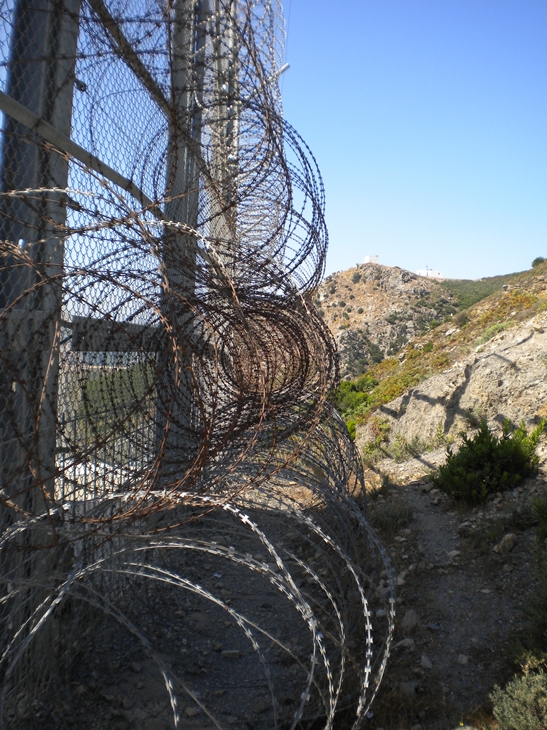Fences are built all over the western world to fight back what is advocated to be an ‘intrusion of immigrants’ when the percentage of people migrating remains steadily at 3% of the global polulation. At the same time, such border closing practices have proven useless and crimminally dangerous, while they only serve to build the profile of the dangerous ‘other’ that comes to take away our freedom and prosperity.
By Ruben Andersson via British Politics and Policy
This post has been turned into an animated video with the support of The Three Minute Post.
Migration panic is upon Calais yet again. Amid desperate and determined attempts by refugees and migrants to clamber over fences or scramble to reach UK-bound ferries, the media have over the past month painted a picture of yet another impending invasion. Police have launched crackdowns; far-right extremists have massed on the city; and French politicians have lobbied hard for a stronger British involvement in controls. In response to the chaos, the UK first offered to send France the “ring of steel” fences recently used at the NATO summit; now it has pledged £12m over three years, earmarked―among other things―for the building of robust security barriers around Calais port. Fencing, the UK immigration minister has made clear, is one key element in efforts to “send out a very clear message… [that] Britain is no soft touch when it comes to illegal immigration.”
When the Berlin wall came down in 1989, border barriers briefly seemed a thing of a dark and authoritarian past. Yet in recent years, fence-making has become a booming business. The US-Mexico border is now traced by pedestrian fences and vehicle barriers that stretch, in stops and starts, from the Pacific Ocean to the mouth of the Rio Grande. The Israeli “security barrier” undulating through Palestinian olive groves seeks to keep terrorists out, while its more recent counterpart between the Sinai and Negev deserts targets African refugees and migrants. Around the Spanish enclaves of Ceuta and Melilla in North Africa, as well as at the Greek-Turkish land border, similar anti-migration fences have been erected. Bulgaria is now following suit with its own barrier, built in sight of remnants of communist-era fences meant to keep people in. All these barriers have one thing in common: they do not shield nation-states against the traditional military menace at borders, but instead target new transnational “threats”―including, most strikingly and prominently, the so-called “illegal” immigrant.
 Most informed migration commentators, from scholars to policymakers and border police, agree that such fencing is useless. In her seminal Walled States, Waning Sovereignty, Wendy Brown sees barriers and fences as a “psychic defence against systemic failures,” projecting state power onto an increasingly ungovernable terrain. Similarly, the IPPR’s Tim Finch recently called the Calais chaos “essentially irresolvable” since desperate travellers “will just try another way” to reach the UK. As for politicians, the Spanish state secretary for security last week admitted that migration policy “is not all about putting up razor wire and barriers”―precisely what his government has been doing, to no avail, over the past years. Border guards, too, frequently voice frustrations at the fences, or as one Spanish Civil Guard officer in Ceuta bluntly told me during fieldwork in 2010: “The barrier is useless.” The European Commission seconded this view when refusing to fund Greece’s border fence, calling it “pointless.”
Most informed migration commentators, from scholars to policymakers and border police, agree that such fencing is useless. In her seminal Walled States, Waning Sovereignty, Wendy Brown sees barriers and fences as a “psychic defence against systemic failures,” projecting state power onto an increasingly ungovernable terrain. Similarly, the IPPR’s Tim Finch recently called the Calais chaos “essentially irresolvable” since desperate travellers “will just try another way” to reach the UK. As for politicians, the Spanish state secretary for security last week admitted that migration policy “is not all about putting up razor wire and barriers”―precisely what his government has been doing, to no avail, over the past years. Border guards, too, frequently voice frustrations at the fences, or as one Spanish Civil Guard officer in Ceuta bluntly told me during fieldwork in 2010: “The barrier is useless.” The European Commission seconded this view when refusing to fund Greece’s border fence, calling it “pointless.”
Yet there is more to border fences than pointlessness. They do work, but rarely in the way intended. Instead, by creating ever more dramatic and dangerous entry methods, they feed the phenomenon they are meant to address―which in turn tends to ensure their reinforcement in perpetuity.
We see this at the US-Mexico frontier, where the Bush-era Secure Border Initiative spectacularly floundered, and where tough controls have simply directed migrants towards deadly stretches of desert. We see it, too, at Europe’s southern external borders, where fences have only “succeeded” in temporarily pushing migrants and refugees towards longer and more dangerous routes―that is, towards risky sea crossings across the Mediterranean and the Atlantic. Sooner or later, however, the migrants return to the fences, in ever more spectacular fashion.
Spain’s North African enclave of Melilla, one of the locations visited in my new book Illegality, Inc., illustrates these absurd and tragic dynamics. When the first undocumented sub-Saharan migrants arrived there in the 1990s, they simply walked across the enclave’s border. Then the first fences were built to keep them out, and suddenly a “threat scenario” emerged. The migrants now came running uncontrollably―the only way of entering. As cooperation with Morocco deepened, increasing crackdowns fed the desperation among migrants, who came to see the fences around Melilla and Ceuta as a last escape route. As a result, the fences were strengthened again in 2005 with the help of EU funds. In Melilla, triple fences soon rose six metres above ground, accompanied by sensors, thermal cameras, pepper-spray mechanisms, bright spotlights and an intricate mesh of steel cables meant to trap any intruder. This mass display of force “worked” for a while―until 2013 and 2014, when desperate migrants found new ways across. This February, 15 migrants died when they tried to swim around Ceuta’s fortified sea perimeter, dodging rubber bullets fired by the Spanish civil guards. Yet despite the violence, the migrants keep coming, triggering calls for further investments, on top of the €72m already spent on the fences since 2005. Madrid has asked for more money from Brussels; fortified the Melilla border with manpower, razor wire and an anti-climbing mesh; and extended cooperation with Morocco―which now involves building one more fence outside Melilla’s triple barrier, as well as another on the long border with Algeria.
In the UK case, the immigration minister inadvertently pointed to a similarly absurd circle of controls when he boasted that “millions of pounds have already been invested in improving security and upgrading technology in Calais.” This technology has not halted clandestine entry attempts―and any new barrier in port is equally unlikely to achieve this aim.
With this in mind, how come fences keep being built? The cue is in the UK minister’s stated goal: to “send out a very clear message” on the toughness of controls. Not to migrants, who hardly need such a reminder. Rather, this messaging is meant for a domestic audience―and especially for the news media. At fences, the “tide” of migration washing over European countries can after all most easily and spectacularly be rendered visible.
In this sordid border game, many sectors other than media outlets now hold a stake. Defence contractors, for instance, now market their “solutions” on a global scale, easily grafting their fence technology or surveillance systems on to new settings, from Israel and Europe to Arizona. Yet from my anthropological perspective, more interesting than the financial gains are the intricate networks and dependencies created around seemingly impenetrable divides. In calling the fences “useless,” the Spanish border guard above simply sought to highlight the crucial role played by Moroccan forces in intercepting “intruders” before they reach the fences. Around the fences of Ceuta and Melilla, complex networks have been created in which African and European border forces are drawn ever closer together, alongside other actors responding to their efforts: smugglers offering new routes, activists seeing barriers as ideal sites of protests, aid workers tending to those who come across, distressed or wounded―and, of course, migrants themselves, who may use the fences to stage precisely the spectacular entries the media hope for. Here the dramatic fence-building has created a border ecosystem of sorts, in which all sorts of incentives―financial, social and political―contribute to the continued drama at the border.
To break this vicious circle, we first need to take a rational look at migrant numbers. In Calais and Melilla, a few thousand potential entrants have spawned very similar “crises”―even as total immigrant numbers for European Union member states stand, at the last count, at 3.4 million a year. Meanwhile, 86 per cent of the world’s refugees are hosted by developing countries, not Western nations. The spectacular fence-building and patrolling of external borders, then, is not only counterproductive―it is also targeting a wildly inflated “problem.”
Second, the border fences highlight in stark fashion how debates about who should be able to enter―important as these may be―are rather pointless unless we also consider whether states can control migration flows as they wish at a time when goods and capital flow freely across borders and transnational social networks grow ever more intricate. Indeed, the structural demand for labour―quite in spite of any border policing measures―has time and again been shown to be a prime driver of international migration. The increasingly vicious cross-border conflicts in Europe’s neighbourhood, pushing refugees to move, show equally clearly how hard-handed attempts to halt human movement are bound to fail.
Instead of pretending that fence-building will solve anything, it is high time that we “unfence” our views of migration. On the one hand, this means seeking other, more humane responses to human movement, including orderly refugee resettlement. On the other, it means not seeing migration as a self-contained “problem” in need of a security response―but rather as an intrinsic part of a world inexorably on the move.

